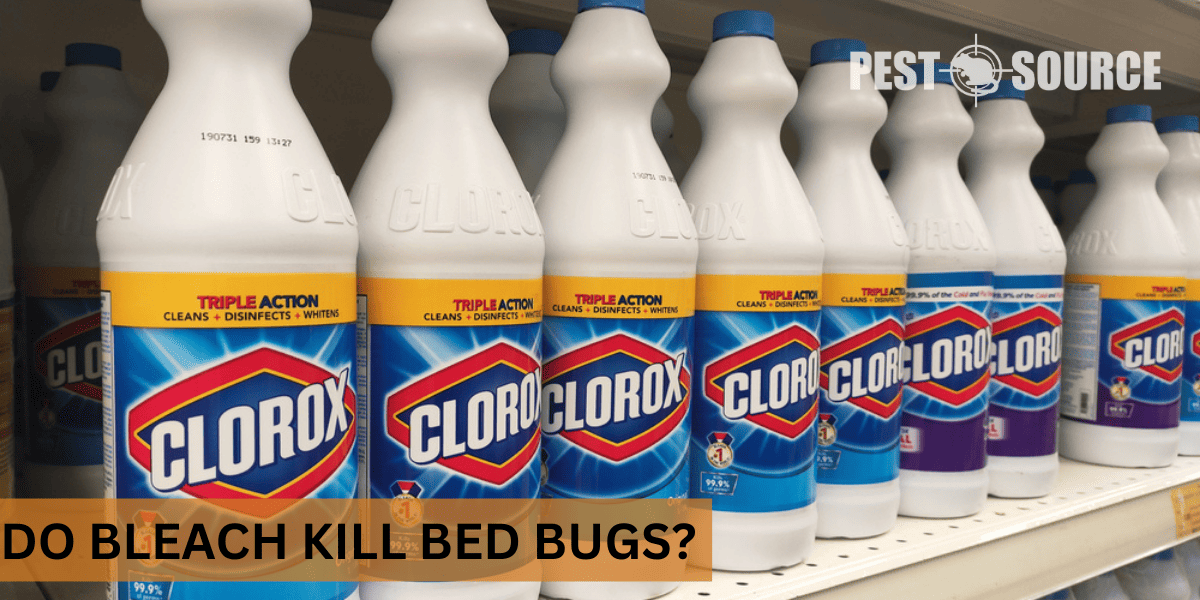Bleach can kill bed bugs on contact by oxidizing their outer shell and internal organs. However, using bleach is not a foolproof or recommended method for infestation control due to its corrosive nature and inability to reach hidden bugs or eggs. The following text will delve into the use of bleach against bed bugs and safer, more effective alternatives.
POINTS
- Bleach can kill bed bugs on direct contact due to the oxidizing properties of its main components, primarily sodium hypochlorite. It effectively damages the bug’s exoskeleton, leading to dehydration and death.
- The effectiveness of bleach against bed bug eggs is uncertain. Though bleach could potentially eliminate the eggs if it penetrates their protective layer, achieving this is quite challenging.
- Different types of bleach like Clorox, chlorine, and bleach water have varying effectiveness against bed bugs, all reliant on direct contact and precision for success. Of the three, pure bleach is the most potent.
- Using bleach for bed bug control has potential drawbacks. It can damage furniture and belongings due to its strong chemical nature, and its fumes are toxic, potentially causing skin and respiratory irritation.
- While bleach does have some killing capacity against bed bugs, professional pest control services and other safe, comprehensive methods such as heat treatment and use of bed bug-proof mattress covers are more reliable for substantial infestations.
The Bed Bug Dilemma and the Use of Bleach
Bed bugs are tiny, nocturnal insects that feed on human blood, often causing skin irritation and allergic reactions. Their small size and capability to hide in tiny crevices make them a challenging pest to deal with.
What is the current understanding about bleach’s effect on insects, specifically bed bugs?
Bleach, also known as sodium hypochlorite, is known for its strong oxidizing properties. This, in theory, can be potent enough to destroy a bed bug’s exoskeleton. However, the nature of bed bugs’ behavior and their ability to hide in inaccessible places make it difficult for bleach to achieve total extermination.
How is bleach thought to kill bed bugs?
Bleach is considered to kill insects by oxidizing their protective exoskeleton, causing dehydration and, ultimately, death. When applied to the bed bugs directly, it’s believed to essentially “burn” through their exoskeleton, leading to their demise.
Understanding Bleach and Its Composition
Knowing how bleach works and what it contains can help us understand its effects on bed bugs.
What is bleach and how does it work?
Bleach is a widely-used disinfectant that kills bacteria, fungus, and viruses. It achieves this by breaking the chemical bonds in their molecules. Once these bonds are broken, the harmful microorganisms are destroyed.
What are the main components of bleach, including chlorine and its function?
Bleach is primarily composed of water and sodium hypochlorite. Once it is mixed with water, it breaks down into its components, including chlorine. Chlorine is responsible for bleach’s disinfectant properties. It is a powerful oxidizer that is capable of breaking the chemical bonds of whatever it comes into contact with.
Effectiveness of Bleach in Killing Bed Bugs
If you’re facing a bed bug infestation, it’s vital to understand the efficacy of various control methods, including bleach.
Does bleach kill bed bugs?
Yes, bleach can kill bed bugs, mainly due to its content of chlorine that acts as an oxidizing agent, effective in damaging their exoskeleton. However, it’s important to note that bleach must come directly in contact with the bed bugs to work, which can be challenging considering the insects’ elusive nature.
How does bleach interact with bed bugs?
Bleach can cause harm to bed bugs by oxidizing a bug’s protein structure found within its exoskeleton, causing the bed bug to lose water content and die. It also disrupts their growth and reproductive cycle by affecting their reproductive organs.
How long does it take bleach to kill bed bugs?
Espying the exact time bleach takes to kill the bugs might be hard, but generally, if bed bugs get directly exposed to bleach, they’re likely to die within a few hours at most.
Can bleach kill bed bug eggs, and if so, how effective is it?
While bleach can kill bed bugs, its effectiveness on their eggs is less concrete. Bleach may have problems penetrating the protective layer of the bed bug eggs. However, if it does penetrate, the strong oxidizing properties of bleach could potentially eliminate the eggs.
Can bleach kill bed bugs and their eggs simultaneously?
In ideal conditions, with direct contact and saturation, bleach could potentially kill bed bugs and their eggs simultaneously. Nonetheless, these perfect conditions are quite difficult to achieve, so relying on bleach for a complete solution may not be ideal.
Exploring Different Types of Bleach in Bed Bug Eradication
There are various types of bleach used in household disinfection. Does the efficacy against bed bugs change based on these variants?
Does Clorox, a popular brand of bleach, kill bed bugs?
Clorox, a widely recognized brand of bleach, can kill bed bugs if used properly and in direct contact. As with generic bleach, however, ensuring that every bug and egg gets exposed to Clorox is nearly impossible due to their elusive nature.
Does using chlorine or Clorox have different effects on bed bugs?
Both Clorox and chlorine can erode the exoskeleton of bed bugs, leading to their death. The impact on bugs by both agents is virtually the same as they share the same active ingredient, sodium hypochlorite.
What is the difference between using bleach water and pure bleach?
Pure bleach is more potent than diluted bleach water, but it’s also more hazardous to our health and can damage belongings. While bleach water may be less risky, it also likely reduces the effectiveness against the bed bugs.
What are the differences between bleach water, Clorox, and disinfectants in their effectiveness against bed bugs?
All three substances share the same common active ingredient, sodium hypochlorite, but vary in their concentrations. Their effectiveness against bed bugs will almost certainly decrease in the following order: pure bleach, Clorox, and then bleach water. Remember, all require direct contact with bed bugs to be effective.
Impact of Bleach on Bed Bugs’ Behavior
Identifying how bleach affects bed bug behavior can provide insights into the merits of this pest control method.
Do bed bugs like bleach or its smell?
Bed bugs do not like bleach or its smell. Bleach is a strong chemical agent that can deter these critters. However, a dislike for bleach doesn’t mean it will force them to leave your home.
Does bleach attract bed bugs, or does it keep bugs away?
While the strong smell of bleach might deter bed bugs and keep them at bay for a while, it does not attract or lure them out. Bleach is no guarantee to drive an infestation out of hiding permanently.
Comparing Bleach to Other Bed Bug Control Methods
With various remedies available for bed bug infestation, it’s useful to compare their effectiveness with bleach.
Can other disinfectants kill bed bugs?
Yes, other disinfectants can kill bed bugs. Still, their effectiveness greatly depends on the particular active ingredients they contain. Also, as with bleach, direct contact is necessary for success.
Does Lysol Kill Bed Bugs?
Lysol can kill bed bugs if it comes into direct contact with them due to its ethanol and isopropyl alcohol content. However, Lysol is not an effective method for controlling bed bug infestations as it does not provide lasting protection and cannot penetrate into the small crevices where bed bugs hide and lay eggs. Professional pest control treatments are more reliable for thoroughly eliminating bed bug populations.
How does bleach compare to other methods such as hot water for bed bug extermination?
Hot water is typically more effective at killing bed bugs than bleach, primarily when used effectively through methods such as heat treatment. Unlike bleach, heat can penetrate into hard-to-reach areas, ensuring a more total extermination.
Does a combination of hot water and bleach enhance effectiveness against bed bugs?
Using a combination of hot water and bleach might seemingly enhance the effectiveness. However, this method may not be safer or better than others due to potential hazards related to handling bleach.
Potential Drawbacks and Hazards of Using Bleach for Bed Bug Control
Although bleach can kill bed bugs, it’s important to consider the potential detriments of using this household cleaner for pest control.
Can bleach damage furniture and other belongings when used for bed bug control?
Yes. Bleach can discolor fabrics and damage other materials, making it a less ideal choice for use on your furniture and belongings.
What are the health and safety considerations in using bleach as a pest control method?
While bleach is accessible and potent, it’s also toxic and caustic. Its fumes can irritate the skin, eyes, and respiratory system, and can be potentially harmful if ingested or applied to the skin undiluted. Therefore, caution is needed when using bleach as a bed bug control method.



